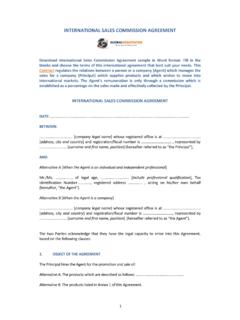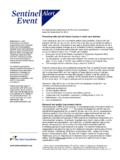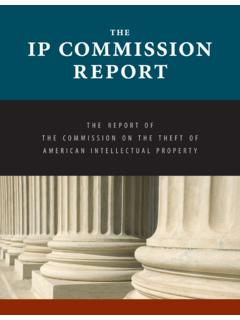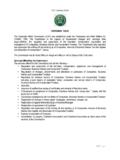Transcription of Report of the Commission to Assess the Threat to …
1 Report of the Commission to Assess the Threat to the United States from Electromagnetic Pulse (EMP) Attack Critical National Infrastructures _____. For sale by the superintendent of Documents, Government Printing Office Internet: Phone: toll free (866) 512-1800; DC area (202) 512-1800. Fax: (202) 512-2104 Mail: Stop IDCC, Washington, DC 20402-0001. ISBN 987-0-16-080927-9. Report of the Commission to Assess the Threat to the United States from Electromagnetic Pulse (EMP) Attack Critical National Infrastructures Commission Members Dr. John S. Foster, Jr. Mr. Earl Gjelde Dr. William R. Graham (Chairman). Dr. Robert J. Hermann Mr. Henry (Hank) M. Kluepfel Gen Richard L. Lawson, USAF (Ret.). Dr. Gordon K. Soper Dr. Lowell L. Wood, Jr. Dr. Joan B. Woodard April 2008. CRITICAL NATIONAL INFRASTRUCTURES. Table of Contents Page vi Acknowledgements .. ix Chapter 1. Infrastructure 1. SCADA 1. Impact of SCADA Vulnerabilities on Critical Infrastructures: Historical Insight.
2 6. Infrastructures and Their 9. Commission -Sponsored Modeling and Simulation (M&S) Activities .. 13. Summary .. 15. 16. Chapter 2. Electric Power .. 17. 17. Description .. 20. 29. Test Results .. 37. Historical Insights .. 41. Distinctions .. 43. Strategy .. 45. 53. Chapter 3. Telecommunications .. 62. 62. Telecommunications Support During Emergencies .. 64. EMP Impact on 65. 79. Chapter 4. Banking and 83. 83. The Financial Services 85. Vulnerability to EMP .. 88. Consequences of Financial Infrastructure Failure .. 92. 94. Chapter 5. Petroleum and Natural Gas .. 95. 95. Infrastructure Description .. 95. Direct Effects of EMP on Petroleum and Natural Gas 98. Petroleum Infrastructure and SCADA .. 98. Natural Gas Infrastructure and SCADA .. 99. Effects of an EMP Event on the Petroleum and Natural Gas 100. Indirect Effects of EMP: Accounting for Infrastructure Interdependencies .. 102. 103. Chapter 6. Transportation Infrastructure.
3 105. 105. Long-Haul Railroad .. 106. The Automobile and Trucking 112. Maritime Shipping .. 116. Table of Contents ii CRITICAL NATIONAL INFRASTRUCTURES. Commercial 122. 127. Chapter 7. Food Infrastructure .. 129. 129. Dependence of Food on Other 129. Making, Processing, and Distributing 130. Vulnerability to EMP .. 132. Consequences of Food Infrastructure Failure .. 134. 137. Chapter 8. Water 139. 139. The Water Works .. 140. Vulnerability to EMP .. 142. Consequences of Water Infrastructure 143. 146. Chapter 9. Emergency Services .. 147. 147. Emergency Services Systems Architecture and Operations .. 147. Impact of an EMP 149. 156. Chapter 10. Space 158. 158. Terms of Reference for 159. Line-of-Sight Exposure to a Nuclear Detonation .. 159. Persistently Trapped Radiation and Its 161. Nuclear Weapon Effects on Electronic 162. Satellite Ground Stations .. 167. Discussion of Results .. 168. 170. 171. Chapter 11. 172. 172. Maintaining Government Connectivity and 172.
4 172. Chapter 12. Keeping The Citizenry Informed: Effects On People .. 176. 176. Impact of an EMP 176. 181. Appendix A. The Commission and Its A-1. A-1. Method .. A-2. Activities .. A-2. Appendix B. B-1. Table of Contents iii CRITICAL NATIONAL INFRASTRUCTURES. List of Figures Page Figure 1-1. Typical SCADA Architecture .. 2. Figure 1-2. Generic SCADA 3. Figure 1-3. PLC Switch Actuator .. 4. Figure 1-4. EMP Simulator with Test Structures and Internal Electronics .. 5. Figure 1-5. Some of the Electronic Control Systems Exposed in Test Facility .. 6. Figure 1-6. Physical Model Used to Quantify Coupling to Different Cable Lengths in a Hypothetical Local Area Network (LAN) .. 7. Figure 1-7. A Conceptual Illustration of the Interconnectedness of Elements Contained Within Each Critical Infrastructure.. 12. Figure 1-8. Interdependency for Anticipated Network of the Future .. 14. Figure 1-9. Results of a Model 15. Figure 2-1. Power System Overview.
5 21. Figure 2-2. NERC Interconnections .. 25. Figure 2-3. GIC Damage to Transformer During 1989 Geomagnetic Storm .. 33. Figure 2-4. EMP 38. Figure 2-5. Test Item: Electronic 40. Figure 2-6. Flashover Observed During Injection Pulse Testing .. 41. Figure 3-1. Generic Telecommunications Network 66. Figure 3-2. September 11, 2001, Blocked Call Rate Cellular 70. Figure 3-3. Example Network Management Facility .. 71. Figure 3-4. Cellular Base Station Equipment .. 72. Figure 3-5. Routers Collecting Network Management Data .. 72. Figure 3-6. Cellular Network Testing at INL .. 74. Figure 3-7. Testing at NOTES 74. Figure 3-8. Secure Access Card and Cell 75. Figure 3-9. Percentage of Calls Completed Immediately After EMP 76. Figure 3-10. Percentage of Calls Completed 4 Hours After EMP Event .. 76. Figure 3-11. Percentage of Calls Completed 2 Days After EMP 77. Figure 3-12. Percentage of Calls Completed at Time T (Logarithmic Time Scale). (Within EMP Contours).
6 77. Figure 5-1. Petroleum 96. Figure 5-2. Natural Gas 97. Figure 5-3. Typical SCADA Arrangement for Oil 99. Figure 5-4. SCADA Integrates Control of Remote Natural Gas 100. Figure 5-5. Examples of Oil Interdependencies .. 102. Figure 5-6. Examples of Natural Gas Interdependencies .. 102. Figure 6-1. 2003 Class I Railroad Tons 107. Figure 6-2. CSXT Train Dispatch Center .. 108. Figure 6-3. Typical Block Signal Control Equipment Enclosure .. 110. Figure 6-4. Grade Crossing Shelter and Sensor Connection .. 110. Figure 6-5. Modern Locomotive Functional Block Diagram .. 111. Figure 6-6. A Typical Signalized 113. Figure 6-7. Container Cranes and Stored Containers .. 117. Figure 6-8. RTG at Seagirt Marine Terminal .. 118. Figure 6-9. Handheld Wireless Data 119. Table of Contents iv CRITICAL NATIONAL INFRASTRUCTURES. Figure 6-10. Truck Control 119. Figure 6-11. An ARTCC Operations Room .. 122. Figure 9-1. A Generic Modern Emergency Services System.
7 148. Figure 10-1. From left to right, the ORANGE, TEAK, KINGFISH, CHECKMATE, and STARFISH high-altitude nuclear tests conducted in 1958 and 1962 by the United States near Johnston Island in the mid- Pacific .. 159. Figure 10-2. Satellite Orbits Illustrated .. 159. Figure 10-3. Areas of Space Irradiated by Photons and 160. Figure 10-4. Naturally occurring belts (Van Allen belts) of energetic particles persistently trapped in the geomagnetic field are illustrated .. 161. Figure 10-5. Schematic diagram of relative intensities of trapped fluxes from two identical high-altitude nuclear detonations .. 161. Figure 10-6. Satellites remaining after a 10 MT burst over Lake 167. Figure 10-7. Satellite ground-based receiver outage time after a 10 MT. burst over Lake 167. Figure 10-8. HEO satellite exposure to trapped radiation produced by Events 11, 17, and 168. List of Tables Table 3-1. Telecommunications Equipment Tested .. 73. Table 10-1.
8 Trial Nuclear 163. Table 10-2. Analysis of Satellites .. 164. Table 10-3. Probability That Satellites Suffer Damage by Direct Exposure to X-Rays .. 165. Table 10-4. Trial Events in Group 1 .. 165. Table 10-5. Trial Events in Group 2 .. 166. Table 10-6. Trial Events in Group 3 .. 166. Table of Contents v CRITICAL NATIONAL INFRASTRUCTURES. Preface The physical and social fabric of the United States is sustained by a system of systems;. a complex and dynamic network of interlocking and interdependent infrastructures ( critical national infrastructures ) whose harmonious functioning enables the myriad actions, transactions, and information flow that undergird the orderly conduct of civil society in this country. The vulnerability of these infrastructures to threats deliberate, accidental, and acts of nature is the focus of greatly heightened concern in the current era, a process accelerated by the events of 9/11 and recent hurricanes, including Katrina and Rita.
9 This Report presents the results of the Commission 's assessment of the effects of a high altitude electromagnetic pulse (EMP) attack on our critical national infrastructures and provides recommendations for their mitigation. The assessment is informed by analytic and test activities executed under Commission sponsorship, which are discussed in this volume. An earlier executive Report , Report of the Commission to Assess the Threat to the United States from Electromagnetic Pulse (EMP) Volume 1: Executive Report (2004), provided an overview of the subject. The electromagnetic pulse generated by a high altitude nuclear explosion is one of a small number of threats that can hold our society at risk of catastrophic consequences. The increasingly pervasive use of electronics of all forms represents the greatest source of vulnerability to attack by EMP. Electronics are used to control, communicate, com- pute, store, manage, and implement nearly every aspect of United States ( ) civilian systems.
10 When a nuclear explosion occurs at high altitude, the EMP signal it produces will cover the wide geographic region within the line of sight of the This broad band, high amplitude EMP, when coupled into sensitive electronics, has the capa- bility to produce widespread and long lasting disruption and damage to the critical infrastructures that underpin the fabric of society. Because of the ubiquitous dependence of society on the electrical power system, its vulnerability to an EMP attack, coupled with the EMP's particular damage mecha- nisms, creates the possibility of long-term, catastrophic consequences. The implicit invi- tation to take advantage of this vulnerability, when coupled with increasing proliferation of nuclear weapons and their delivery systems, is a serious concern. A single EMP attack may seriously degrade or shut down a large part of the electric power grid in the geo- graphic area of EMP exposure effectively instantaneously.








